Abstract
Background:
This study aimed to understand the impact of garlic on improving blood lipids using a meta-analysis.
Methods:
A literature search of the PubMed, EMBASE, and Cochrane Library databases was performed using keywords such as “garlic” and “hypercholesterolemia,” and the deadline “July 14 (th), 2017.” After extracting relevant details, each selected literature was evaluated for quality according to the quality evaluation criteria of bias risk recommended by Cochrane Collaboration recommendations and heterogeneity tests were performed. Standardized mean difference (SMD) and 95% confidence interval (CI) were evaluated using R 3.12 software. The publication bias was assessed using Egger method.
Results:
A total of 14 eligible papers published from 1981 to 2016 were included. The quality of the literatures was of moderate to high qualities. The values of TC (SMD = –1.26, 95% CI, –1.86 to –0.66), low-density lipoprotein (LDL) (SMD = –1.07, 95% CI, –1.67 to –0.47), and high-density lipoprotein (HDL) (SMD = 0.50, 95% CI, 0.06–0.94) after taking garlic in the experimental group and the control group have statistical significance, while there was no significant difference of TG in the 2 groups (SMD = –0.16, 95% CI, –0.87–0.55). However, the result of HDL was reversed when removed some of the literatures. No significant publication bias among the eligible studies with values of TC (P = .0625), LDL (P = .0770), HDL (P = .2293), and TG (P = .3436).
Conclusion:
Garlic can reduce the level of TC and LDL instead of HDL and TG, indicating the ability of anti-hyperlipidemia.
Keywords: cardiovascular disease, garlic, high-density lipoprotein, hypercholesterolemia, low-density lipoprotein, total cholesterol, triglyceride
High Lights
-
1.
Garlic had anti-hyperlipidemia ability.
-
2.
Intake of garlic induced the level of TC and LDL.
-
3.
The level of TG in serum had no obvious difference with and without garlic treatment.
1. Introduction
Recently, cardiovascular disease (CVD), a complex and multifactorial disease, remains one of the serious diseases that threaten human health worldwide with increasing incidence and mortality year by year.[1] Unfortunately, 17 million people die to CVD each year and it is estimated to reach 24.8 million in 2030 in the world.[2] The most important risk factors of CVD are hypertension, high cholesterol, alcohol intake, and tobacco usage, etc. according to the World Health Organization statistics.[3] Dyslipidemia including high total cholesterol (TC), low-density lipoprotein cholesterol (LDL-C), and triglyceride (TG), as well as decreased high-density lipoprotein cholesterol (HDL-C) are important causes of CVD.[4] It is well known that an increase in LDL-C concentration is a risk factor for CVD and is therefore considered to be the primary goal of CVD prevention and treatment.[5] However, nowadays, most of hypolipidemic drugs have relatively great side effects during the treatment of CVD. Thus, a certain component from food with slight side-effect or free of side effects has been paid more and more attentions on the treatment of hyperlipidemia.
Garlic, a perennial herb, plays an important medicinal and dietary role throughout the history. Garlic is used in numerous forms such as extracted oil, powdered garlic tablets, or raw garlic.[6] Ancient Indian and Chinese medicine recommend that garlic can be used to help respiration and digestion, and to treat leprosy and parasitic diseases.[7] Besides, garlic plays important roles in the treatment of many diseases such as infectious diseases (as antibiotic), gynecologic diseases, toothache, arthritis, chronic cough.[7] Because of the widespread effects of garlic in maintaining good health, it has attracted particular attention of modern medicine. Importantly, the favorable effects are mainly attributed to diminution of risk factors for CVDs, antimicrobial effect, antioxidant effect, reduction of cancer risk.[8,9] The protective mechanisms of the beneficial effects of garlic in CVDs may be achieved by suppressing LDL oxidation, increasing HDL, as well as decreasing TC and TG.[10–12] A class of sulfur-containing organic compounds (including S-allylcysteine, alliin, ajoene, diallyl disulfide) in garlic has pharmacological effects.[13,14]
The effect of garlic in anti-hyperlipidemia has been confirmed in some animal studies, but all of them have small size of samples. Besides, a meta-analysis was performed in 2013 by Ried et al,[15] but the studies published by Jung et al,[5] Ahmad Alobaidi,[16] and Negar et al[6] are not included. Thus, in this study to increase the sample size, we used meta-analysis to understand the impact of garlic on improving blood lipids. Our study might provide a basis for clinical research.
2. Materials and methods
This meta-analysis was performed based on the Preferred Reporting Items for Systematic Reviews and Meta-Analyses (PRISMA) guidelines.[17]
2.1. Data sources
The related clinical researches were obtained from the electronic databases PubMed (http://www.ncbi.nlm.nih.gov/pubmed/), Embase (http://www.embase.com), and Cochrane Library (http://www.cochranelibrary.com) with garlic (“ALLIUM SATIVUM” OR “Garlic”) and hypercholesterolemia (“Hypercholesterolemia” OR “Hypercholesterolaemia” OR “Hypercholesterolemic” OR “Hyperlipidemic” OR “Hyperlipidaemia” OR “Hyperlipidemia” OR “Dyslipidemia” OR “Dyslipidemias”) as searched keywords; and a deadline of “July 14 (th); 2017.”
2.2. Eligibility criteria
Articles meeting the following criteria were selected (based on the PICOS principle): published English literatures to study the efficacy of garlic in the treatment of hypercholesterolemia (P); participants in the experimental group was hyperlipidemia patients treated with garlic (I) and that in the control group was hyperlipidemia patients with placebo (C) treatment; the outcomes of the study included the initial values as well as the values after treatment of TC (serum total cholesterol), LDL (low density lipoprotein), HDL (high density lipoprotein), and TG (triglyceride), and the amount of changes was included (O); the study type was randomized parallel study (study design: parallel; crossover study: excluded) (S). The following articles were removed: studies with incomplete data or can’t be used for statistical analysis; literatures such as reviews, reports, comments, and letters. Besides, if multiple literatures were repeatedly published or multiple literatures studied based on the same population data, only the latest research or the research with complete information was included.
2.3. Data extraction and quality evaluation of literature
Data were independently extracted from the included literatures by 2 reviewers and included details such as: first author, published year, area of study, year of study, the type and dose of garlic, follow-up time, number as well as general demographic data (e.g., sex ratio, age composition, body mass index [BMI], etc.) of inclusion in the garlic group and the control group; the initial values as well as the values after treatment of TC, LDL, HDL, and TG in the garlic group and the control group.
The aggregate quality of the included studies was evaluated according to the quality evaluation criteria of bias risk, recommended by Cochrane Collaboration recommendations.[18] A third reviewer should join in and discuss with the other 2 reviewers to get an agreement if there was disagreement in the process of data extraction and quality evaluation.
2.4. Statistical analysis
The meta-analysis of direct comparison was conducted using R 3.12 software (R Foundation for Statistical Computing, Beijing1, China, “meta” package), SMD (standardized mean difference), and 95% confidence interval (CI) were used to show the effect index of quantitative data. The heterogeneity test between studies was assessed based on the Q test[19] and the I2 statistic, and P < .05 or I2 > 50% was used as the heterogeneity threshold. The random effect model was chosen when they had significant heterogeneity; otherwise, the fixed-effect model was chosen to pool the data.[20] The publication bias was assessed using Egger method. Finally, the sensitivity analysis was performed by examining the effect of this document on the overall SMD value by ignoring a document each time.
3. Results
3.1. Characteristics of the selected literature
A total of 956 articles (243 articles came from PubMed database, 645 articles came from Embase database, 68 ones came from Cochrane Library) were identified based on the literature search criteria. Among them, 207 articles were repeated, and 618 articles were irrelevant after reading title and abstract. In addition, 117 articles (including 15 letters, 11 case series/report, 28 reviews, 31 animal study, 13 descriptive studies, 12 non-RCT, and 7 reduplicative studies) of the remaining 131 articles were removed by reviewing full text. Finally, 14 eligible papers which were published from 1981 to 2016 were included (Fig. 1).[5,6,16,21–31]
Figure 1.
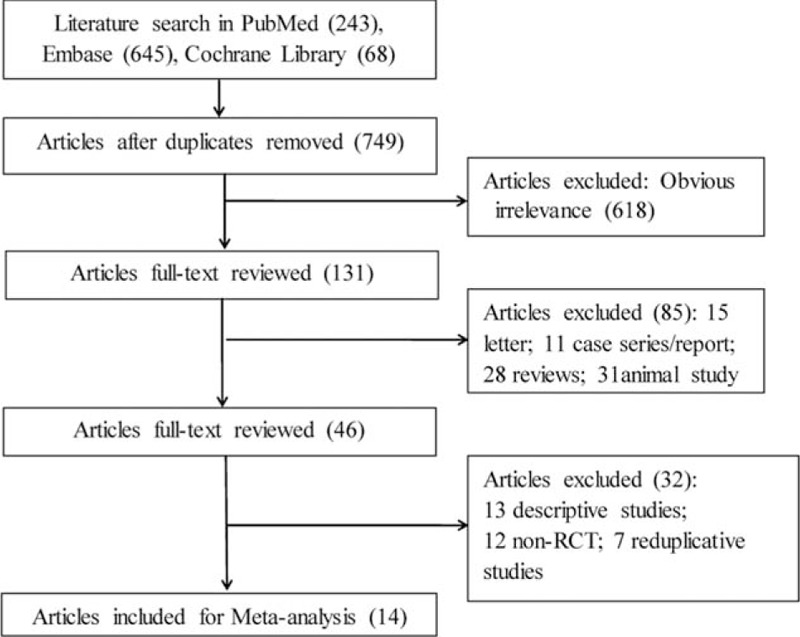
Literature search and study selection.
Totally, 1093 hyperlipidemia patients were included in the study, including 527 cases in the experimental group and 566 cases in the control group. Most of the areas of these studies were India, Canada, the United States, and South Korea; the types of garlic were aged black garlic (BG), garlic oil (GO), and garlic powder (GP) with the doses ranged from 0.3 to 20 g/d; the patients were followed up for 4 weeks to 10 months; the baseline characteristics between the experimental group and the control group were comparable in terms of age, sex, and BMI/Body weight (Tables 1 and 2). The results of RCT quality evaluation showed that the quality of the literatures we incorporated were of moderate to high qualities (Fig. 2A, B).
Table 1.
Characteristics of the included literatures.
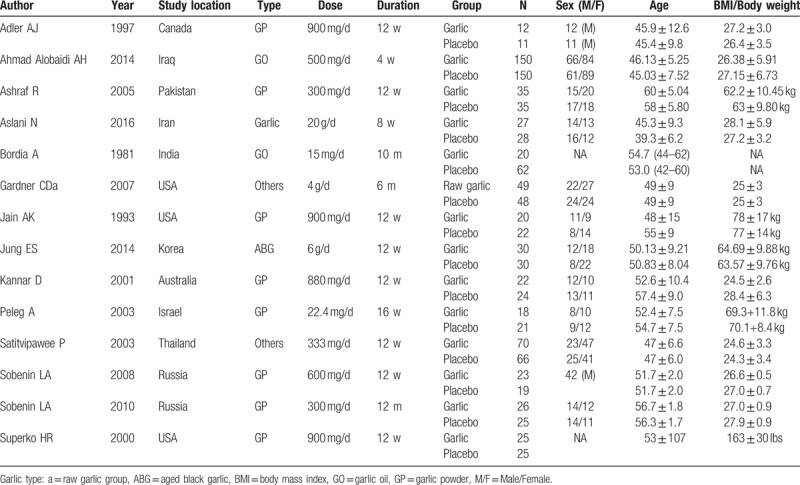
Table 2.
Detailed data of the included literatures.
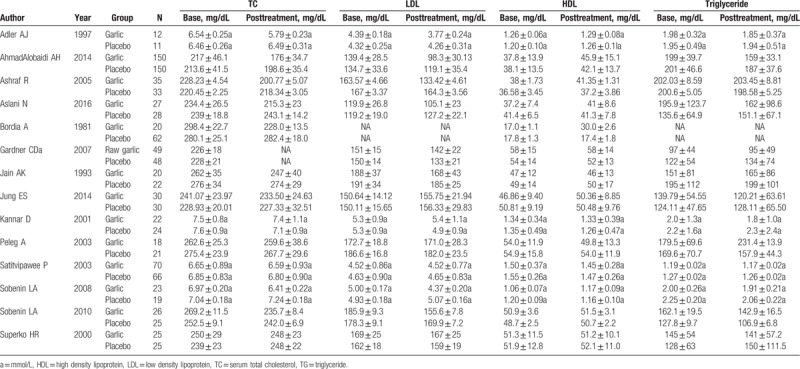
Figure 2.
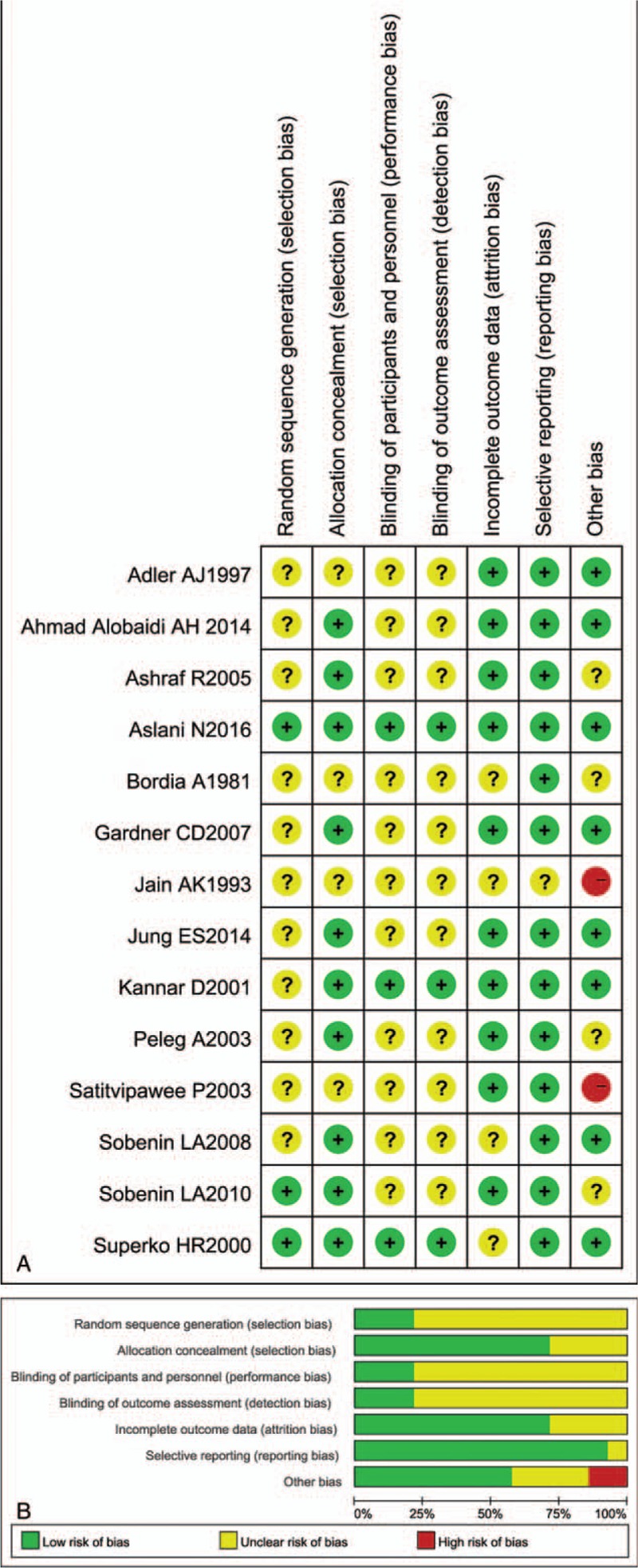
Quality assessments of the included studies. A. Sensitivity and specificity of the included studies. B. Bias risk of the included studies. “+”: low risk of bias; “–”: high risk of bias, and “?”: unclear risk of bias.
3.2. Combination of quantitative data of meta-analysis
The values of TC, LDL, HDL, and TG in the experimental group and the control group after taking garlic were analyzed by meta-analysis. Based on the heterogeneity test results (P < .05, I2 > 50%), all results including TC (P < .0001, I2 = 94%), LDL (P < .0001, I2 = 94.2%), HDL (P < .0001, I2 = 91.1%), and TG (P < .0001, I2 = 95.9%) were pooled using random model.
The results of meta-analysis showed that the values of TC, LDL, and HDL after taking garlic in the experimental group and the control group have statistical significance. Among that, garlic treatment decreased the values of TC (SMD = –1.26, 95% CI, –1.86 to –0.66, Fig. 3) and LDL (SMD = –1.07, 95% CI, –1.67 to –0.47, Fig. 4) while increased that of HDL (SMD = 0.50, 95% CI, 0.06–0.94, Fig. 5), indicating the important role of garlic in changing blood lipids. However, there was no significant difference of TG in the 2 groups (SMD = –0.16, 95% CI, –0.87–0.55, Fig. 6).
Figure 3.
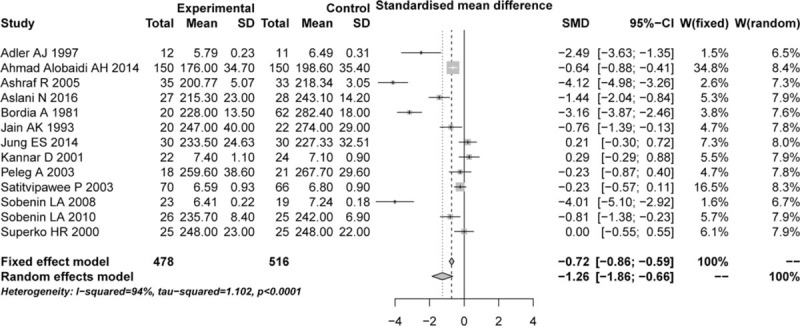
Comparison of TC value after garlic treatment between the experimental group and the control group. TC = serum total cholesterol.
Figure 4.
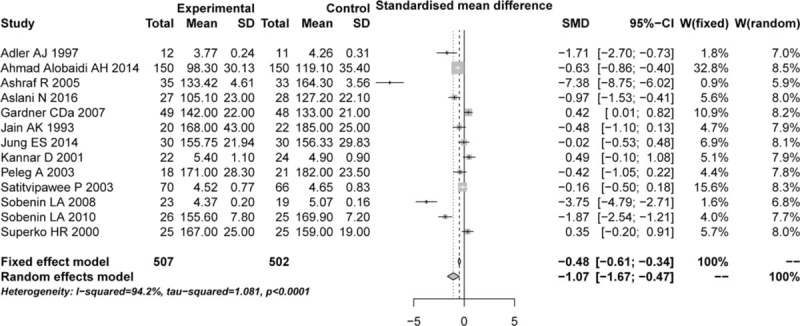
Comparison of LDL value after garlic treatment between the experimental group and the control group. LDL = low density lipoprotein.
Figure 5.
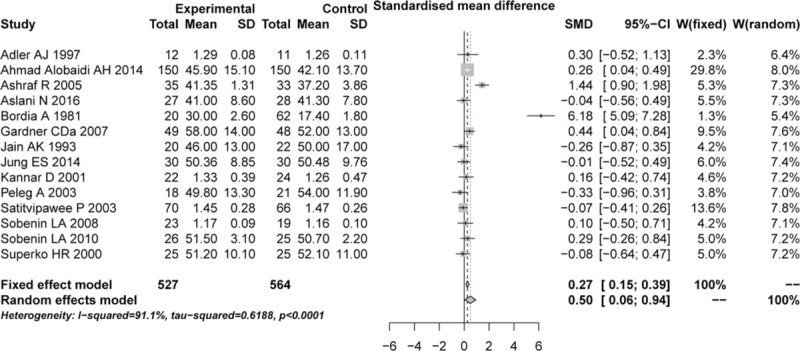
Comparison of HDL value after garlic treatment between the experimental group and the control group. HDL = high density lipoprotein.
Figure 6.
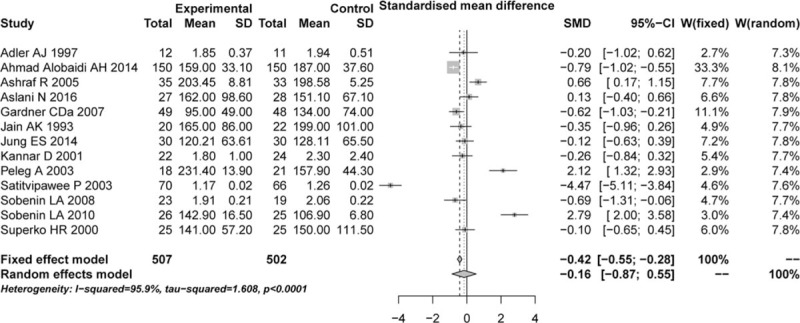
Comparison of TG value after garlic treatment between the experimental group and the control group. TG = triglyceride.
3.3. Publication bias
Egger test was used to assess the publication biases in the analyses of TC, LDL, HDL, and TG values. Our results showed no significant publication bias among the eligible studies with values of TC (P = .0625), LDL (P = .0770), HDL (P = .2293), and TG (P = .3436, Table 3).
Table 3.
Results of meta-analysis.

3.4. Sensitivity analysis
The sensitivity analysis results revealed that any of the literature can’t change the results of TC, LDL, and TG, indicating that the results of TC, LDL, and TG were stable. However, the result of HDL was reversed when removed some of the literatures (Ashraf[23] and Bordia[24]).
4. Discussion
In order to evaluate the reliability of previous studies, a meta-analysis evaluating the hypolipidemic effect of garlic was conducted in this study. Our finding revealed that the values of TC, LDL, and HDL after taking garlic in the experimental group and the control group have statistical significance. However, there was no significant difference of TG in the 2 groups.
Garlic is gained substantial interest by many researchers because of the its impact on lipid levels.[32,33] Garlic is discovered has multiple useful cardiovascular effects including reduction in cholesterol and TG, lowering of blood pressure, and enhancement of fibrinolytic activity.[34] Many studies have demonstrated that different extracts of garlic can alone lower the level of serum TC, LDL, and TG in humans and rodents.[35,36] Similarly, Maha et al[37] have revealed that the level of plasma TC and LDL-C can be decreased by adding 8% raw garlic into the diet of rats. In 1993, Warshafsky et al[38] have proved that intake of garlic can reduce the cholesterol level by about 10%. Besides, combination of lemon juice and garlic obviously decreased serum TC, LDL-C, and blood pressure.[6] Nevertheless, someone have indicated that garlic powder doesn’t reduce cholesterol levels, which may due to the loss of active compound(s) during processing.[39] Garlic may decrease the absorption of cholesterol, and the synthesis of cholesterol and fatty acid, and thereby reduces the level of cholesterol.[40] The human enzymes required in cholesterol biosynthesis such as squalene monooxygenase and HMG-CoA (3-hydroxy-3-methylglutaryl-coenzyme A) reductase can be inhibited by garlic and various constituents.[41–45] Garlic may decrease the level of LDL-C by reduction of hepatic cholesterol 7α-hydroxylase, HMG-CoA reductase, pentose-phosphate pathway activities,[46] enhancement of bile acid excretion, microsomal triglyceride transfer protein,[47] cholesteryl ester transfer protein activity,[48] bile acid excretion,[38] and prohibiting hepatic fatty acid synthesis,[49] which was conducted by allicin and/or other components in garlic.[41] Our finding showed the significant differences of TC, LDL, and HDL between the experimental group and the control group, nevertheless, the level of LG was not obviously different. Our results might suggest that the ability of garlic to lower cholesterol and LDL was better than that to lower TG.
Based on the heterogeneity test results, all results including TC, LDL, HDL, and TG were pooled using random model indicating the exist of significant heterogeneity. The appearance of heterogeneity may be due to the following reasons: garlic types were different between different articles, the patients in studies published by Ahmad Alobaidi[16] and Bordia[24] were treated via garlic oil, and that in the study of Jung et al[5] were given via aged black garlic; the dose and duration were dissimilar between different articles, indicating the dose and duration can affect the result of anti-hyperlipidemia; altered detected method might be the influencing factor; the unit of BMI/body weight was dissimilar, Ashraf,[23] Jain et al,[21] Jung et al,[5] and Peleg et al[28] evaluated the physical quality via body weight, while others evaluated that by BMI, thus, it is difficult to compare the physical quality, suggesting physical quality might also affect the results. Besides, in the present study, when removed the literatures published by Ashraf[23] and Bordia,[24] the result of HDL was reversed. The reason might be that garlic increased the level of HDL, and the participants with type 2 diabetes and coronary heart disease were enrolled in the two studies.
However, this research had some limitations as following: this study did not adjust for covariates, and no further conduct subgroup analysis due to the incomplete data of some studies; the reason why specific heterogeneity exit was not determined; the results of HDL value were unstable due to the reverse finding after removed some of the articles.
In conclusion, this study using a meta-analysis demonstrated that garlic can reduce the level of TC and LDL instead of HDL and TG, indicating the ability of anti-hyperlipidemia. Thus, it is recommended that people with high blood lipids can eat more garlic. But this result requires more high-quality studies or a larger sample size of updated meta-analysis to verify.
Author contributions
Conceptualization: Weidong Wang, Yue-E Sun.
Data curation: Jie Qin.
Formal analysis: Jie Qin.
Writing – original draft: Yue-E Sun.
Writing – review and editing: Weidong Wang.
Footnotes
Abbreviations: BG = aged black garlic, BMI = body mass index, CI = confidence interval, CVD = cardiovascular disease, GO = garlic oil, GP = garlic powder, HDL = high-density lipoprotein, HMG-CoA = 3-hydroxy-3-methylglutaryl-coenzyme A, LDL = low-density lipoprotein, PRISMA = Preferred Reporting Items for Systematic Reviews and Meta-Analyses, SMD = standardized mean difference, TC = total cholesterol, TG = triglyceride.
Ethics committee: This is a meta-analysis manuscript, there is no ethics committee or institutional review board approved by the study.
This work was supported by National Natural Science Foundation of China (Program No. 31301535), Six Talent Peaks project in Jiangsu Province (Program No. NY-167), and 333 Project of Jiangsu Province (Program No. BRA2017289).
Competing Interests: The authors declare that they have no competing interests.
References
- [1].Meves H, Nagy K. Cardiovascular disease in Europe 2014: epidemiological update. Eur Heart J 2014;35:2950–9. [DOI] [PubMed] [Google Scholar]
- [2].Estruch R, Ros E, Salas-Salvado J, et al. Primary prevention of cardiovascular disease with a Mediterranean diet. N Engl J Med 2013;368:1279–90. [DOI] [PubMed] [Google Scholar]
- [3].Wood D, Joint European Societies Task F. Established and emerging cardiovascular risk factors. Am Heart J 2001;141(2 Suppl):S49–57. [DOI] [PubMed] [Google Scholar]
- [4].Miller M. Niacin as a component of combination therapy for dyslipidemia. Mayo Clin Proc 2003;78:735–42. [DOI] [PubMed] [Google Scholar]
- [5].Jung ES, Park SH, Choi EK, et al. Reduction of blood lipid parameters by a 12-wk supplementation of aged black garlic: a randomized controlled trial. Nutrition 2014;30:1034–9. [DOI] [PubMed] [Google Scholar]
- [6].Negar A, Hasan EM, Gholamreza A, et al. Effect of garlic and lemon juice mixture on lipid profile and some cardiovascular risk factors in people 30-60 years old with moderate hyperlipidaemia: a randomized clinical trial. Int J Prev Med 2016;7:95. [DOI] [PMC free article] [PubMed] [Google Scholar]
- [7].Bayan L, Koulivand PH, Gorji A. Garlic: a review of potential therapeutic effects. Avicenna J Phytomed 2014;4:1–4. [PMC free article] [PubMed] [Google Scholar]
- [8].Colín AL. The antioxidant mechanisms underlying the aged garlic extract- and S-allylcysteine-induced protection. Oxid Med Cell Long 2012;2012:907162. [DOI] [PMC free article] [PubMed] [Google Scholar]
- [9].Aviello G, Abenavoli L, Borrelli F, et al. Garlic: empiricism or science? Nat Prod Commun 2009;4:1785–96. [PubMed] [Google Scholar]
- [10].Katsuki T, Hirata K, Ishikawa H, et al. Significance of garlic and its constituents in cancer and cardiovascular disease. J Am Acad Dermatol 2006;36:S1–2. [Google Scholar]
- [11].Gardner CD, Chatterjee LM, Carlson JJ. The effect of a garlic preparation on plasma lipid levels in moderately hypercholesterolemic adults. Atherosclerosis 2001;154:213–20. [DOI] [PubMed] [Google Scholar]
- [12].Ziaei S, Hantoshzadeh S, Rezasoltani P, et al. The effect of garlic tablet on plasma lipids and platelet aggregation in nulliparous pregnants at high risk of preeclampsia. Eur J Obstet Gynecol Reprod Biol 2001;99:201–6. [DOI] [PubMed] [Google Scholar]
- [13].Iciek M, Kwiecień I, Wlodek L. Biological properties of garlic and garlic-derived organosulfur compounds. Environ Mol Mutagen 2010;50:247–65. [DOI] [PubMed] [Google Scholar]
- [14].Elbayoumy K, Sinha R, Pinto JT, et al. Cancer chemoprevention by garlic and garlic-containing sulfur and selenium compounds. J Nutr 2006;136(3 Suppl):864S–9S. [DOI] [PubMed] [Google Scholar]
- [15].Ried K, Toben C, Fakler P. Effect of garlic on serum lipids: an updated meta-analysis. Nutrition reviews 2013;71:282–99. [DOI] [PubMed] [Google Scholar]
- [16].Ahmad Alobaidi AH. Effect of Nigella sativa and Allium sativum coadminstered with simvastatin in dyslipidemia patients: a prospective, randomized, double-blind trial. Antiinflamm Antiallergy Agents Med Chem 2014;13:68–74. [DOI] [PubMed] [Google Scholar]
- [17].Liberati A, Altman DG, Tetzlaff J, et al. The PRISMA statement for reporting systematic reviews and meta-analyses of studies that evaluate health care interventions: explanation and elaboration. PLoS Med 2009;6:e1000100. [DOI] [PMC free article] [PubMed] [Google Scholar]
- [18].Higgins JP, Green S. Cochrane Handbook for Systematic Reviews of Interventions. UK: Wiley Online Library, John Wiley & Sons, Ltd; 2008. [Google Scholar]
- [19].Lau J, Ioannidis JP, Schmid CH. Quantitative synthesis in systematic reviews. Ann Inter Med 1997;127:820–6. [DOI] [PubMed] [Google Scholar]
- [20].Feng R-N, Zhao C, Sun C-H, et al. Meta-analysis of TNF 308 G/A polymorphism and type 2 diabetes mellitus. PLoS One 2011;6:e18480. [DOI] [PMC free article] [PubMed] [Google Scholar]
- [21].Jain AK, Vargas R, Gotzkowsky S, et al. Can garlic reduce levels of serum lipids? A controlled clinical study. Am J Med 1993;94:632–5. [DOI] [PubMed] [Google Scholar]
- [22].Adler AJ, Holub BJ. Effect of garlic and fish-oil supplementation on serum lipid and lipoprotein concentrations in hypercholesterolemic men. Am J Clin Nutr 1997;65:445–50. [DOI] [PubMed] [Google Scholar]
- [23].Ashraf R, Aamir K, Shaikh AR, et al. Effects of garlic on dyslipidemia in patients with type 2 diabetes mellitus. J Ayub Med Coll Abbottabad 2005;17:60–4. [PubMed] [Google Scholar]
- [24].Bordia A. Effect of garlic on blood lipids in patients with coronary heart disease. Am J Clin Nutr 1981;34:2100–3. [DOI] [PubMed] [Google Scholar]
- [25].Gardner CD, Lawson LD, Block E, et al. Effect of raw garlic vs commercial garlic supplements on plasma lipid concentrations in adults with moderate hypercholesterolemia: a randomized clinical trial. Arch Intern Med 2007;167:346–53. [DOI] [PubMed] [Google Scholar]
- [26].Sobenin A, Priyanishnikov VV, Kunnova LM, et al. The effects of time-released garlic powder tablets on multifunctional cardiovascular risk in patients with coronary artery disease. Lipids Health Dis 2010;9:119. [DOI] [PMC free article] [PubMed] [Google Scholar]
- [27].Kannar D, Wattanapenpaiboon N, Savige GS, et al. Hypocholesterolemic effect of an enteric-coated garlic supplement. J Am Coll Nutr 2001;20:225–31. [DOI] [PubMed] [Google Scholar]
- [28].Peleg A, Hershcovici T, Lipa R, et al. Effect of garlic on lipid profile and psychopathologic parameters in people with mild to moderate hypercholesterolemia. Isr Med Assoc J 2003;5:637–40. [PubMed] [Google Scholar]
- [29].Satitvipawee P, Rawdaree P, Indrabhakti S, et al. No effect of garlic extract supplement on serum lipid levels in hypercholesterolemic subjects. J Med Assoc Thai 2003;86:750–7. [PubMed] [Google Scholar]
- [30].Sobenin IA, Andrianova IV, Demidova ON, et al. Lipid-lowering effects of time-released garlic powder tablets in double-blinded placebo-controlled randomized study. J Atheroscler Thromb 2008;15:334–8. [DOI] [PubMed] [Google Scholar]
- [31].Superko HR, Krauss RM. Garlic powder, effect on plasma lipids, postprandial lipemia, low-density lipoprotein particle size, high-density lipoprotein subclass distribution and lipoprotein(a). J Am Coll Cardiol 2000;35:321–6. [DOI] [PubMed] [Google Scholar]
- [32].Bhalla K, Hwang BJ, Dewi RE, et al. Metformin prevents liver tumorigenesis by inhibiting pathways driving hepatic lipogenesis. Cancer Prev Res (Phila) 2012;5:544–52. [DOI] [PMC free article] [PubMed] [Google Scholar]
- [33].Augusti KT. Therapeutic values of onion (Allium cepa L.) and garlic (Allium sativum L). Indian J Exp Biol 1996;34:634–40. [PubMed] [Google Scholar]
- [34].Batsis JA, Lopez-Jimenez F. Cardiovascular risk assessment - From individual risk prediction to estimation of global risk and change in risk in the population. BMC Med 2010;8:29. [DOI] [PMC free article] [PubMed] [Google Scholar]
- [35].Budoff MJ, Ahmadi N, Gul KM, et al. Aged garlic extract supplemented with B vitamins, folic acid and L-arginine retards the progression of subclinical atherosclerosis: a randomized clinical trial. Prev Med 2009;49:101–7. [DOI] [PubMed] [Google Scholar]
- [36].Rahman K. Garlic and aging: new insights into an old remedy. Ageing Res Rev 2003;2:39–56. [DOI] [PubMed] [Google Scholar]
- [37].Elmahdi B, Maha MK, Afaf IA. The effect of fresh crushed garlic bulbs (Allium sativum) on plasma lipids in hypercholesterolemic rats. Res J Anim Vet Sci 2008;3:15–9. [Google Scholar]
- [38].Warshafsky S, Kamer RS, Sivak SL. Effect of garlic on total serum cholesterol. A meta-analysis. Ann Intern Med 1993;119((7 Pt 1)):599–605. [DOI] [PubMed] [Google Scholar]
- [39].Isaacsohn JL, Moser M, Stein EA, et al. Garlic powder and plasma lipids and lipoproteins: a multicenter, randomized, placebo-controlled trial. Arch Intern Med 1998;158:1189–94. [DOI] [PubMed] [Google Scholar]
- [40].Matsuura H. Saponins in garlic as modifiers of the risk of cardiovascular disease. J Nutr 2001;131:1000S–5S. [DOI] [PubMed] [Google Scholar]
- [41].Gebhardt R. Multiple inhibitory effects of garlic extracts on cholesterol biosynthesis in hepatocytes. Lipids 1993;28:613–9. [DOI] [PubMed] [Google Scholar]
- [42].Gupta N, Porter TD. Garlic and garlic-derived compounds inhibit human squalene monooxygenase. J Nutr 2001;131:1662–7. [DOI] [PubMed] [Google Scholar]
- [43].Liu L, Yeh YY. Water-soluble organosulfur compounds of garlic inhibit fatty acid and triglyceride syntheses in cultured rat hepatocytes. Lipids 2001;36:395–400. [DOI] [PubMed] [Google Scholar]
- [44].Yeh YY, Liu L. Cholesterol lowering effect of garlic extracts and organosulfur compounds: human and animal studies. J Nutr 2001;131:989S–93S. [DOI] [PubMed] [Google Scholar]
- [45].Augusti KT, Chackery J, Jacob J, et al. Beneficial effects of a polar fraction of garlic (Allium sativum Linn) oil in rats fed with two different high fat diets. Indian J Exp Biol 2005;43:76–83. [PubMed] [Google Scholar]
- [46].Qureshi AA, Din ZZ, Abuirmeileh N, et al. Suppression of avian hepatic lipid metabolism by solvent extracts of garlic: impact on serum lipids. J Nutr 1983;113:1746–55. [DOI] [PubMed] [Google Scholar]
- [47].Lin MC, Wang EJ, Lee C, et al. Garlic inhibits microsomal triglyceride transfer protein gene expression in human liver and intestinal cell lines and in rat intestine. J Nutr 2002;132:1165–8. [DOI] [PubMed] [Google Scholar]
- [48].Song YS, Choi MS, Park SJ, et al. Cholesteryl ester transfer protein activity and atherogenic parameters in rabbits supplemented with cholesterol and garlic powder. Life Sci 2003;72:2953–64. [DOI] [PubMed] [Google Scholar]
- [49].Chang ML, Johnson MA. Effect of garlic on carbohydrate metabolism and lipid synthesis in rats. J Nutr 1980;110:931–6. [DOI] [PubMed] [Google Scholar]


